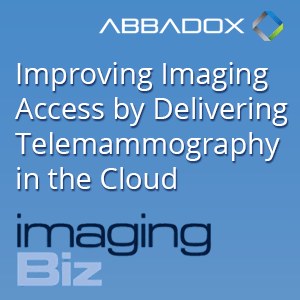Consolidation in the imaging world is often viewed as problematic—but shifting market forces can create opportunities to improve patients’ access to care, points out Kevin Collins, vice president of product management with Sectra. “The imaging market is really polarizing,” he notes. “More and more large hospital networks are acquiring outpatient imaging centers—essentially, they’re reabsorbing the radiology groups and centers that split away from them back in the nineties. The independent groups that are surviving are those that are able to serve multiple organizations that can acquire images on their own, but need people to read them.”
Historically, access to lifesaving exams like screening mammograms has been limited by the financial constraints of organizations that can’t afford dedicated radiologists. But as the remaining independent radiology groups extend their offerings over ever-wider geographic areas, that paradigm is poised to change. “There are a number of smaller organizations that are thinking of offering mammography now,” Collins says, “especially OB/GYN practices that decide they want to get a full-field digital system. The only thing holding them back from offering screening mammograms is the ability to get those exams read on a timely basis.”
PACS in the Cloud
Fortunately, as cloud technology continues to mature, the types of software that can be delivered over the internet is on the rise. That was the driving force behind a new collaboration between Sectra and IDS that leverages IDS’ cloud-based workflow technology to deliver Sectra’s Breast Imaging PACS. CloudFlex, as the new offering is known, is designed specifically to address the needs of low-volume mammography sites by giving them the customized tools they need to manage screening exams efficiently and effectively.
“Teleradiology has been around for some time, but the mammography piece has been left by the wayside,” observes Erik Wagner, managing director of enterprise solutions for IDS. “But as smaller offices and clinics add women’s health components to their offerings, the need for telemammography solutions has grown significantly.”
Judy Franke, managing director of sales and communications for IDS, explains that her company’s cloud technology delivers RIS capabilities while acting as a pipeline through which the capabilities of the Sectra Breast Imaging PACS can be delivered. “We’ve always been in the cloud and have had a lot of success operating as a thin wrapper or layer around other systems,” Franke notes. “We’re very strong in terms of integration and interoperability.”
Delivering the software in this way eliminates hurdles for smaller screening sites, Collins explains. “There’s very little capital investment required on the part of the customer,” he says. “The solution is entirely managed by us, meaning the organization’s costs are very low—they pay only for true usage. This collaboration makes breast imaging and workflow capabilities available to organizations that might otherwise have trouble affording that kind of technology.”
Modular Approach
To lower the barrier to entry even further, CloudFlex is offered by the two companies as a modular solution, allowing organizations to pick and choose the capabilities they need and pay only for what they want. “Some organizations may already have a RIS/PACS, but also have very specific workflow needs that aren’t being met,” Wagner says. “For instance, maybe their system isn’t working as well as a referring physician portal. With CloudFlex, we can deploy only that component as a complement to what they currently have.”
The set of tools offered by CloudFlex includes scheduling, dictation, clinical reporting, speech recognition and critical results management, in addition to Sectra’s breast imaging PACS capabilities and IDS’ cloud-based workflow portal. “It’s a complete women’s health solution that is customizable and changeable,” Wagner says.
Bringing all those capabilities together can be challenging when systems aren’t integrated well. The collaboration between the two vendors ensures seamless functionality, Wagner says. “This package is unique because it seamlessly combines Sectra’s expertise on the PACS side with our expertise on the cloud side,” he notes. “Normalizing data from multiple systems requires intelligent data gathering throughout the process, from creation to report distribution, and that’s where our strength lies.”
Improving Care
With CloudFlex, a single subspecialty radiologist
can serve multiple low-volume mammography sites. “We see a strong opportunity for one radiologist to reach out to rural and smaller communities and offer them top-level care,” Wagner says.
The solution isn’t just about improving access, however, it also can help improve patient care. “When an OB/GYN practice has the ability to forward these exams out to a cloud-hosted service, that doesn’t just benefit them—it also benefits their patients,” Collins says. “Now they don’t have to make an extra, potentially lengthy, trip to get the exam done—they can combine it with another healthcare appointment.”
Wagner concurs. “Women’s health centers everywhere are trying to make this as comfortable an experience for their patients as they can,” he observes. “With this solution, we can take some of the burden off them, so they can focus on the interaction with the patient. With the yearly screening exam taken care of via telemammography, they get the best of both worlds.”





